Make delicious potato gnocchi from the first try, even if you've never made homemade gnocchi before! With step-by-step picture and headnotes you'll learn all Italian secrets to soft, pillowy and flavorful gnocchi.
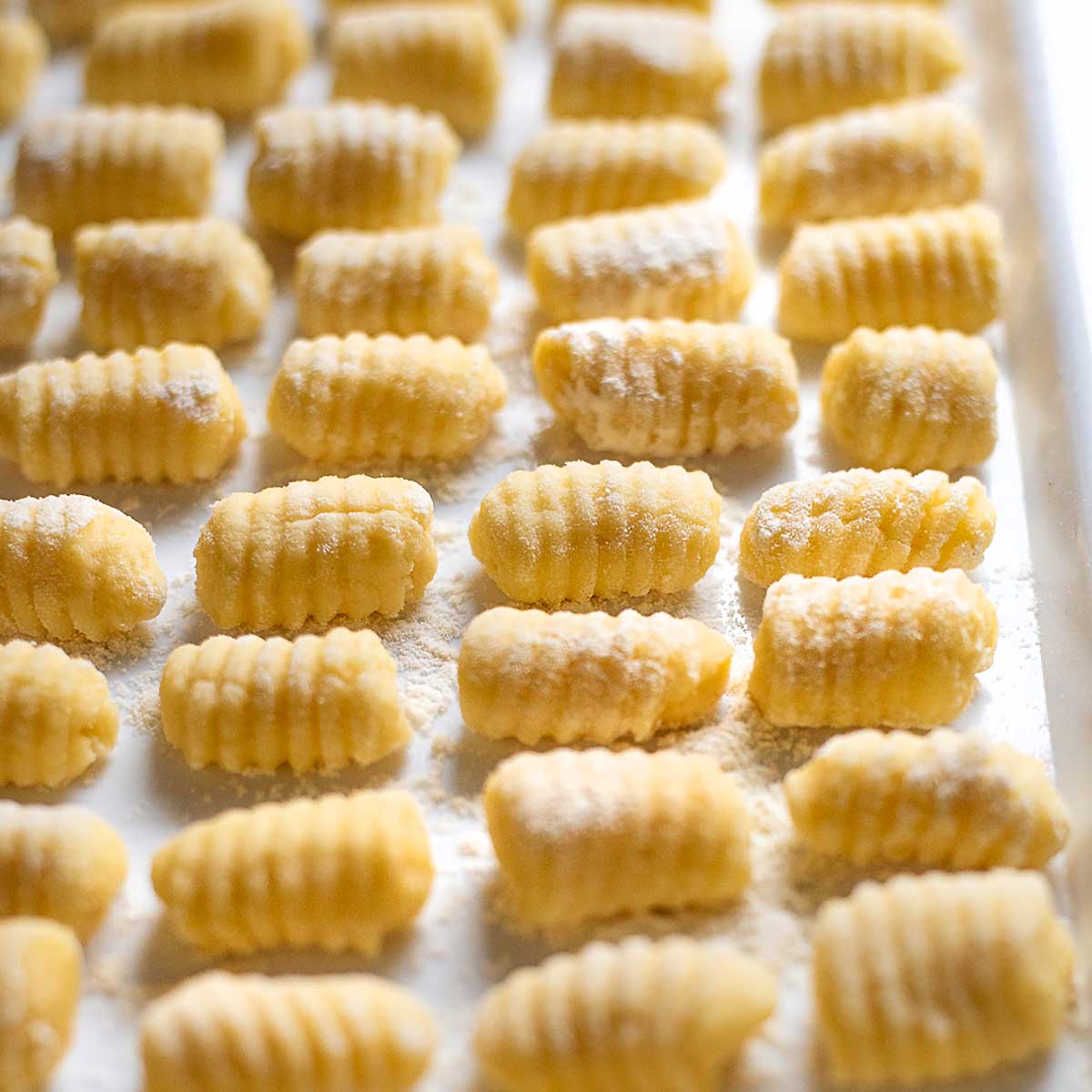
Pesto Gnocchi, Gnocchi Sorrentina, Gnocchi al Pomodoro are just a few ways to enjoy them.
Table Of Contents
Ingredients and Notes
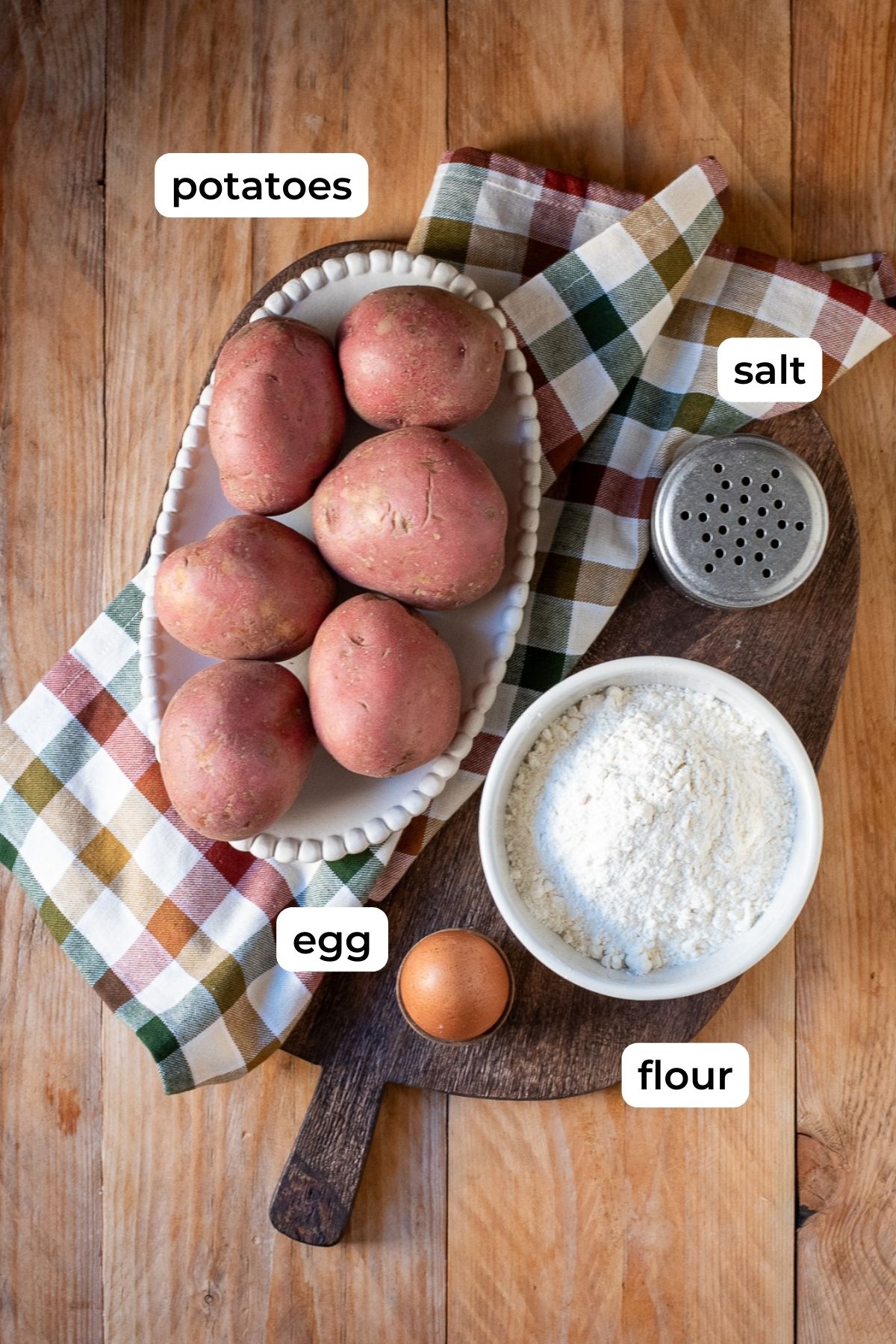
- Potatoes - for perfect gnocchi you need potatoes that have the least amount of moisture. High moisture potatoes will require These are usually mature potatoes with yellow flesh like Yukon gold or Desiree potato. By mature I mean potatoes that are not freshly harvested. Potatoes that are "aged" loose excess moisture. For this reason never use baby potatoes or young potatoes to make gnocchi - they have too much moisture. Yellow fresh potatoes are starchy with less water content compared to potatoes with white flesh.
- Flour - all purpose flour just enough to form the dough, plus more for dusting the work surface.
- Egg - helps bind the dough and give structure to cooked gnocchi. Even though if you're using the right potatoes and bread flour the egg can be omitted.
- Salt - for boiling potatoes and for the dough.
Essential Tools and Alternatives
- Potato Ricer with fine mash attachment - a great and mostly used tool to prepare potatoes for the dough quickly! In fact, Italian nonnas don't even peel the potatoes, since the skin will be captured inside the potato ricer and you'll simply remove it with your hand.
You can use fine mesh food mill in the exact same manner.
Alternatively: use a medium size classic grater. Of course, you'll need to peel potatoes before grating, - Gnocchi Board - helps create those gnocchi signature ridges that hold the sauce. By the way, gnocchi board is not only used to make gnocchi but also to make Italian garganelli pasta and it's so beautiful.
Alternatively: make ridges using a fork or skip making ridges. - Dough scraper or bench scraper - helps combine all the ingredients without overworking the dough.
How To Make - Step By Step
Prepare potatoes
- Start by washing potatoes and putting them in a large pot with cold water. Add salt. Bring potatoes to a boil and cook for 30-40 minutes until tender when poked with a fork.
- Once fork tender, remove potatoes from water immediately and let cool a little bit.
- At this point you can peel off the skin or simply cut off any imperfections, cut in half and later pass through the potato ricer which will hold the skin.
TOP TIP: Choose potatoes more or less of the same size for even cooking.
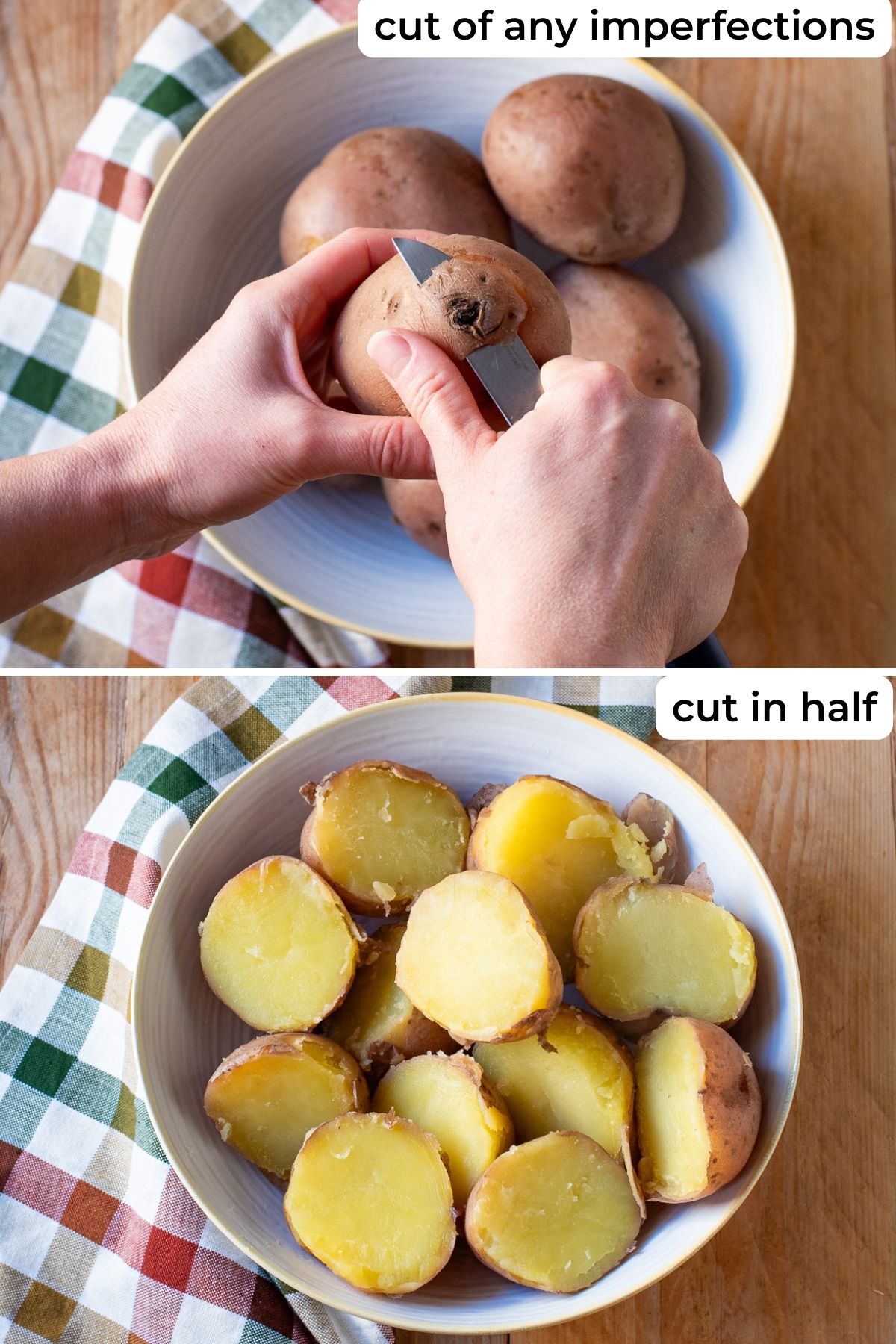
PAY ATTENTION: don't overcook potatoes and don't poke them often. If potatoes crack or you poke them too often to check they'll absorb water through the broken skin which we need to avoid if we want soft and pillowy gnocchi.
Make gnocchi dough
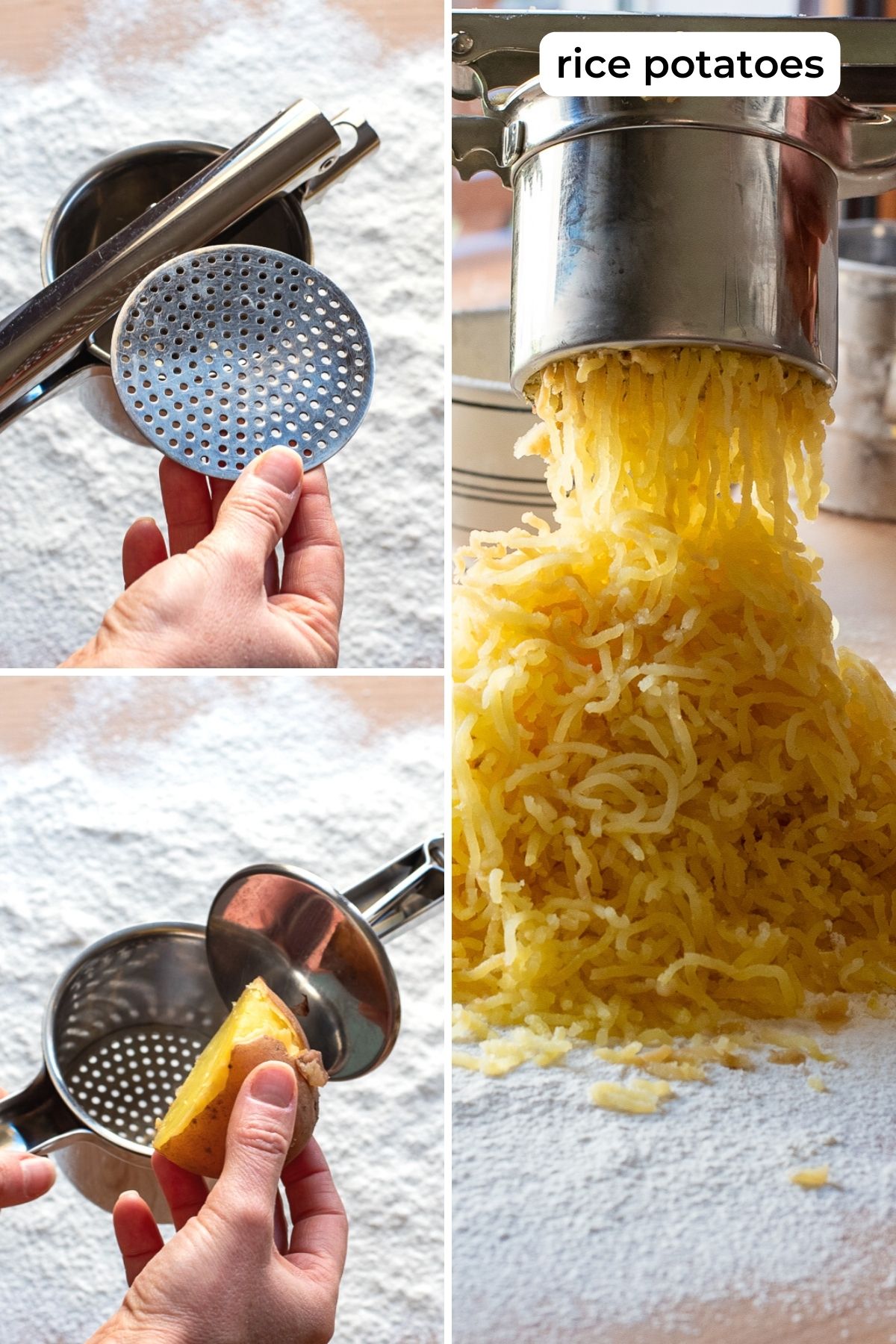
- Sift about ⅓ of all flour on work surface PLUS set 3 tablespoons aside (that you'll add at the very end if needed or use it to roll the gnocchi).
- Rice potatoes placing them cut side down (if you've decided to keep the skin on), force the potato through and remove the skin from the potato ricer.
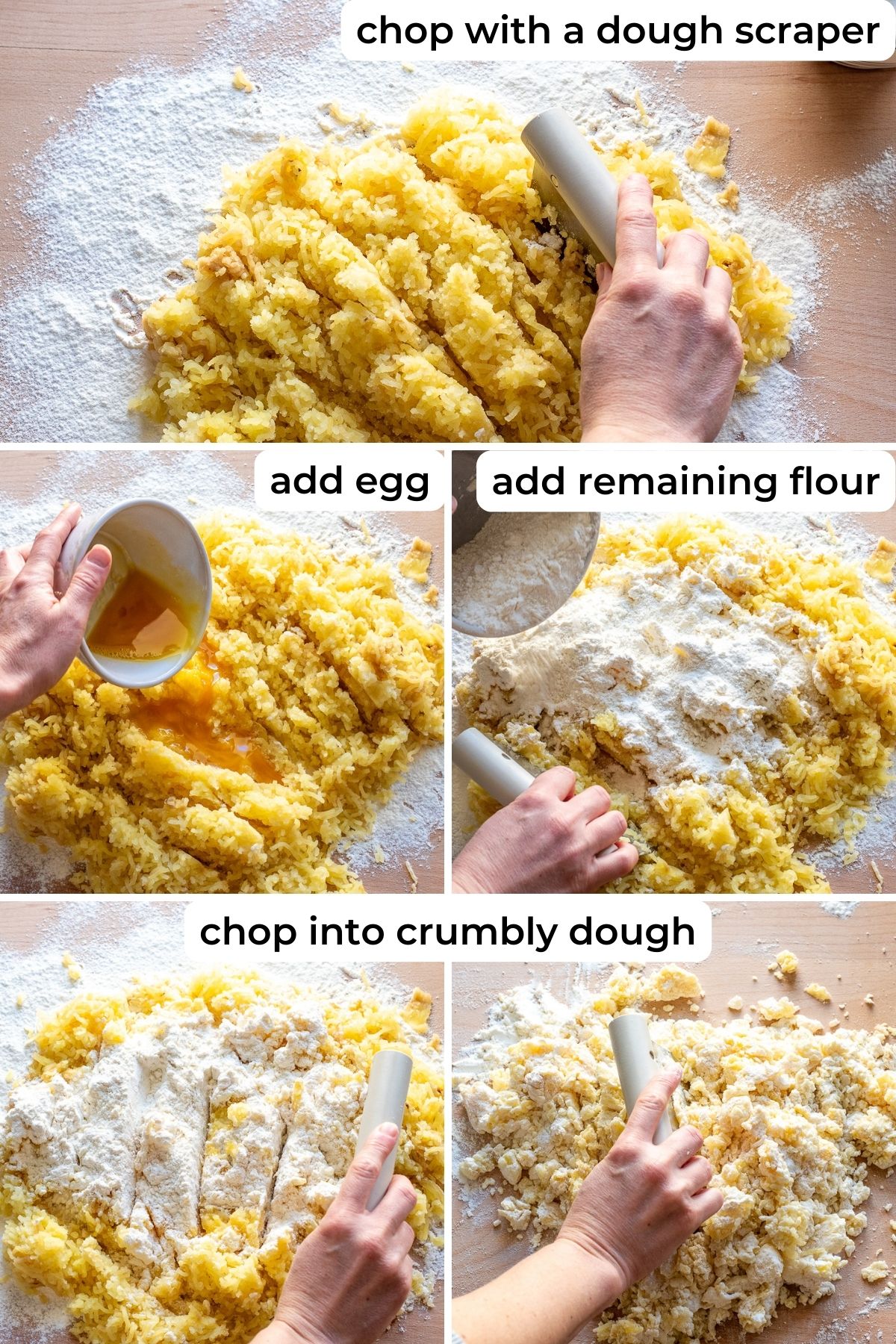
- Using a dough scraper cut riced potatoes to help them cool down further.
- Add beaten egg, and a few pinches of salt. Incorporate briefly with the dough scraper.
- Cover the dough with the remaining flour and "chop" it into a crumbly dough.
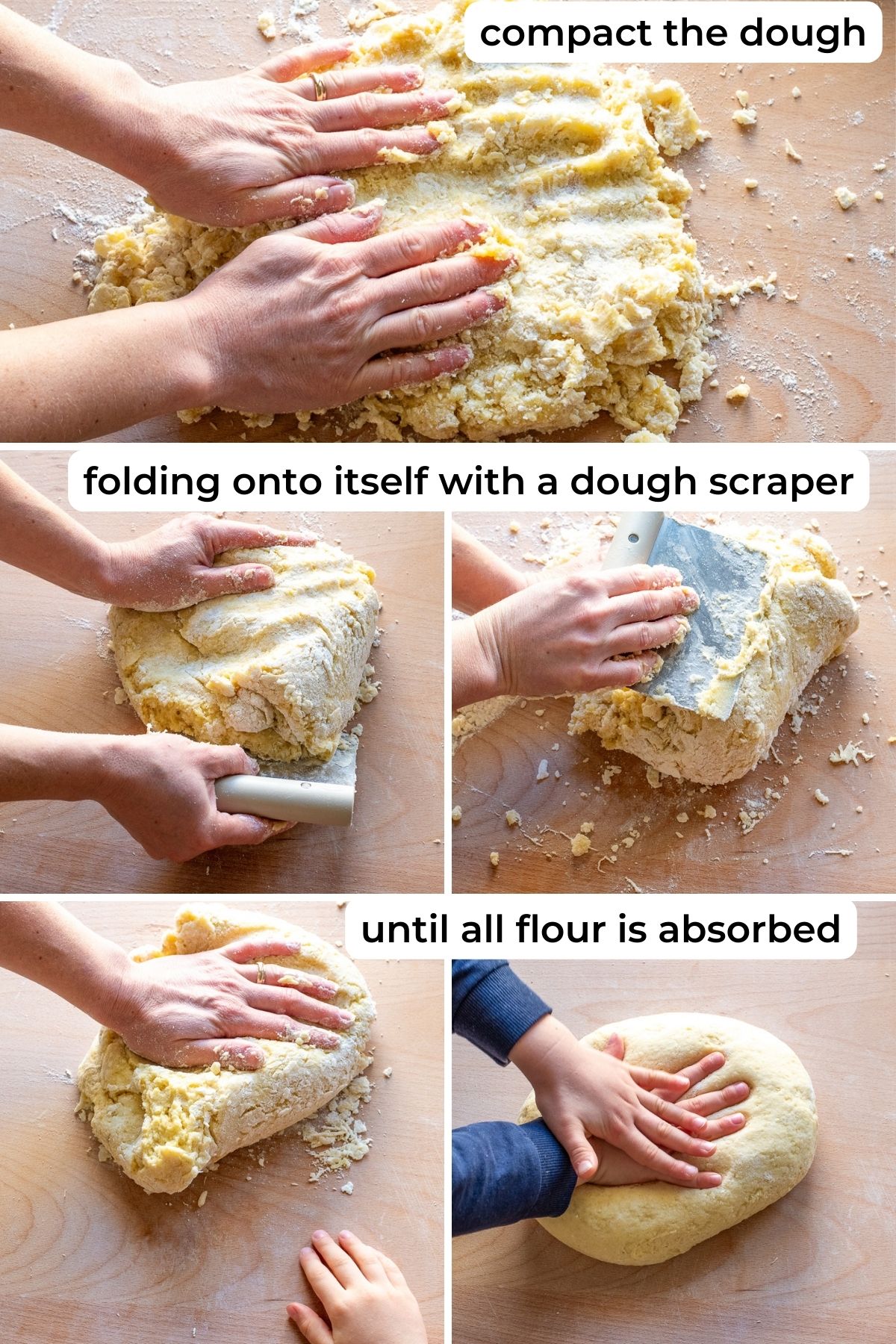
- Now, using your hands compact the dough into a ball.
- Don't knead gnocchi dough as you would with pasta or bread dough. Instead help yourself with a dough scraper and simply FOLD the dough onto itself until all flour is incorporated.
Shape gnocchi
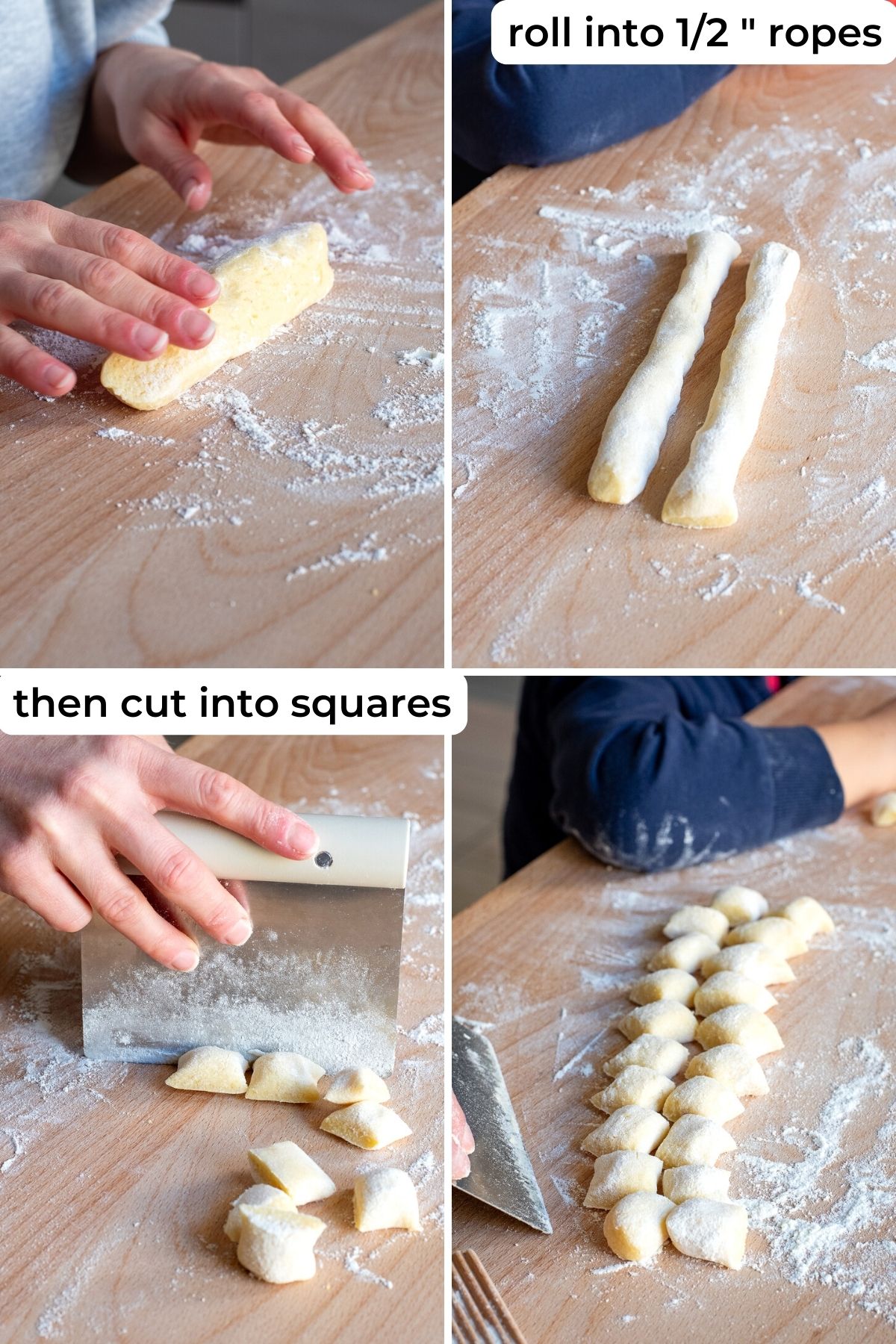
- Dust your work surface with flour and cut off a piece of dough.
- Roll a finger-thick rope, approx. ½ inch thick and cut it into ½- ⅔ inch pillows.
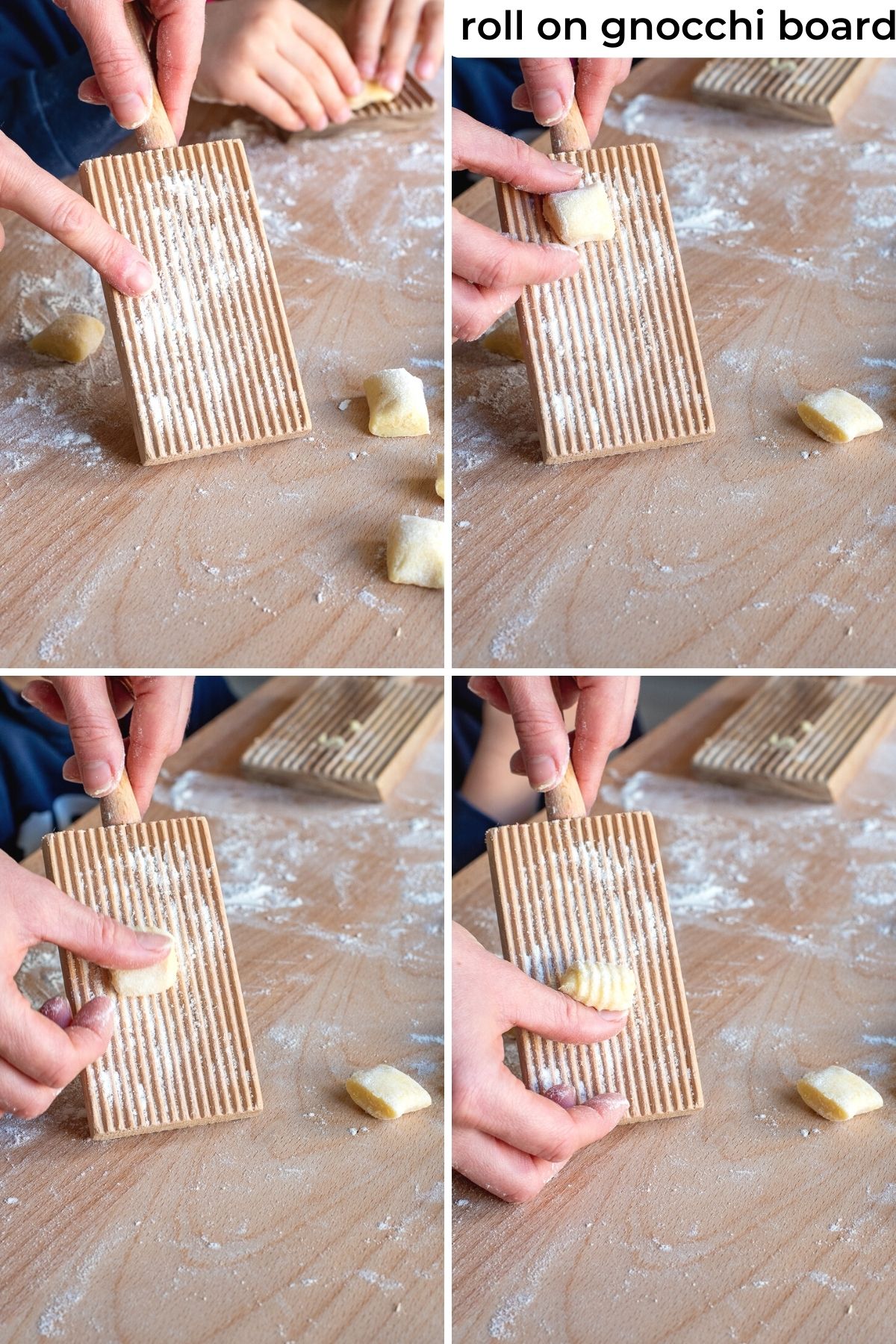
Flour wooden gnocchi board. Using your thumb finger, press and roll each pillow over the gnocchi paddle.
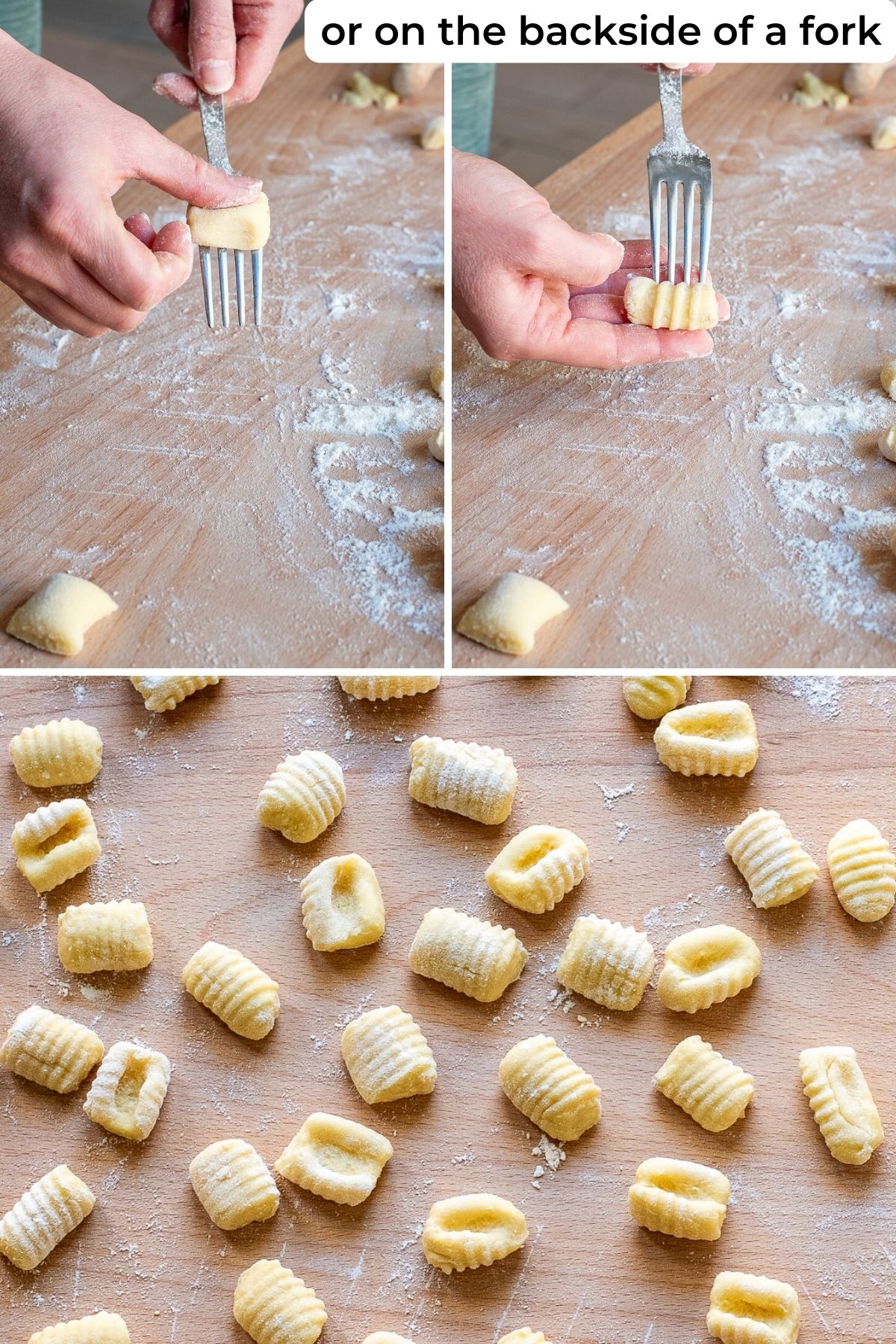
- If you don't have gnocchi board handy, use a simple tool you sure have - a fork. Roll on the backside of a fork pressing lightly to form the ridges. You can also leave your gnocchi ridge-free. They'll taste great anyway.
- Once first batch is ready sprinkle it lightly with more flour to prevent from sticking and arrange on a tray.
- Repeat the process with the rest of the dough.
- Cook potato gnocchi within 30 minutes from making or freeze.
EXTRA TIP: line the tray or wooden board with parchment paper if you plan to freeze gnocchi. Parchment paper will help frozen gnocchi slide directly in the freezer bag without you having to fight them to get off the tray.
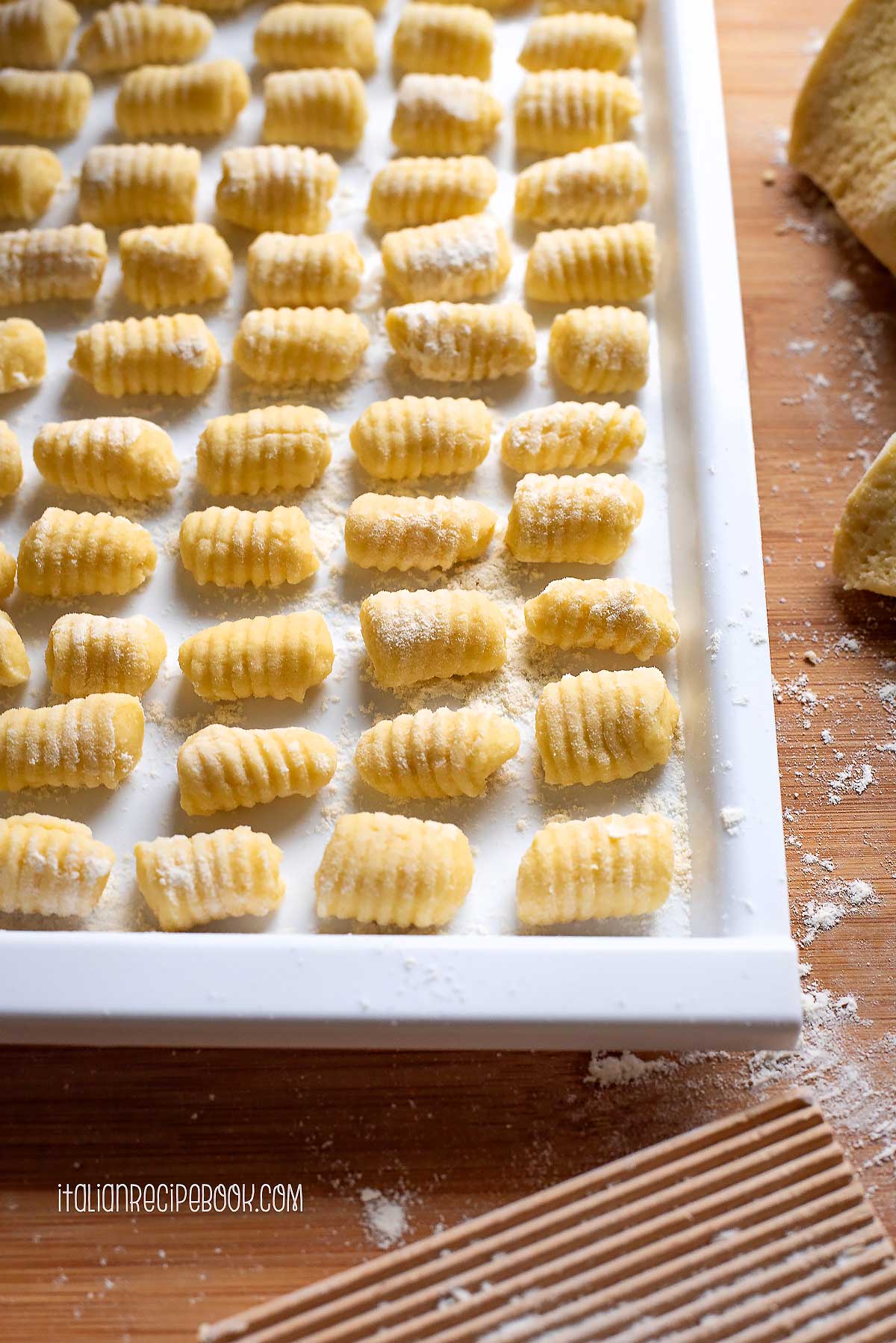
Cook
Cook gnocchi by dropping them in salted boiling water give a very gentle stir. Use a LARGE pot or cook in smaller batches. Don't worry, gnocchi cook very fast. Once they rise and float to the top they're are ready to drain.
Don't use your classic collander. Use skimmer spoon/strainer to drain gnocchi. This way you'll preserve already hot water and can continue cooking the next batch. Make sure the water comes again to a rolling boil before dropping the next batch.
WHY SO: boiling water helps gnocchi cook quickly without falling apart. If you add too many gnocchi is a small pot, the temperature of the water will drop significantly and by the time it comes again to a boil gnocchi will "melt" in the water. So your goal is to make sure gnocchi cook at the highest temperature possible and cook fast. This is especially important when cooking gnocchi from frozen.
Freeze
Line a tray, a board or a baking sheet with parchment paper and arrange gnocchi in a single layer. Pop in the freezer for 30-40 minutes or until they've become hard. Once frozen transfer to a zip-lock bag. They will keep in the freezer for up to 4 months.
TIP: instead of lining with parchment paper you can dust with flour to prevent gnocchi from sticking to the board.
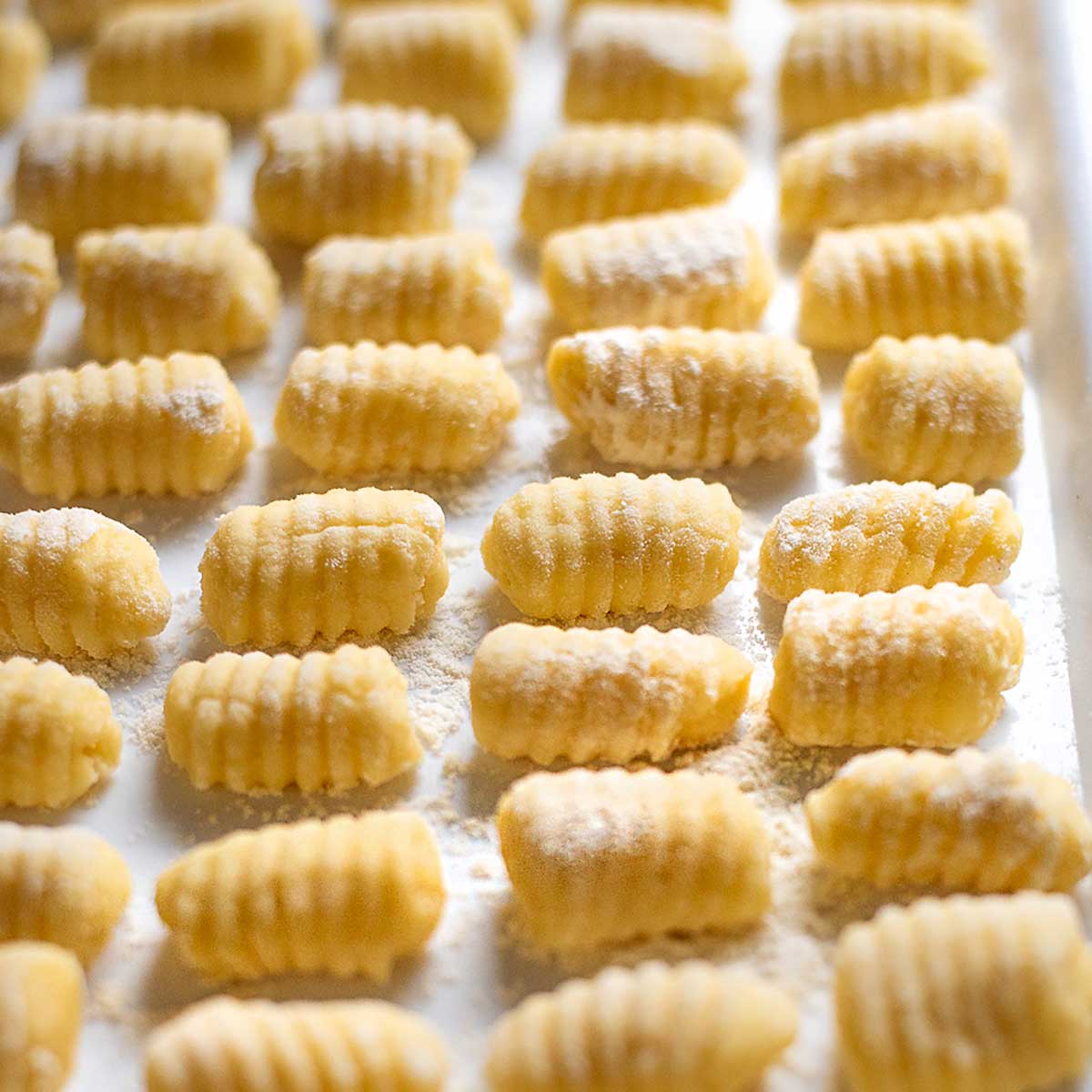
How to Serve Gnocchi
Potato gnocchi can be seasoned with simple sauces like basil pesto, arugula pesto, creamy walnut sauce, Parmesan cream sauce, Asiago cream sauce or simply tossed in a pan with sage and butter.
They can also be cooked in carbonara sauce or you can even make baked gnocchi alla Sorrentina with delicious tomato and mozzarella.
Top Tips and FAQs
- Choose the right potatoes and cook them correctly. Mature/aged potatoes are the best. Never use freshly harvested or young/baby potatoes. Always boil potatoes for gnocchi with skin on. Don’t check on donness before 30 minute mark as you don’t want potatoes to absorb water through poked holes.
- Don’t knead the dough. If you knead gnocchi dough like pasta or bread dough it will need more flour, which will make your gnocchi hard instead of soft and pillowy. Instead, with the help of a dough scraper fold the dough onto itself several times until all flour is absorbed.
- Never let the dough rest. Start making gnocchi immediately once the dough is ready. No need to cover it with a towel either. If you let the dough rest it will soften too much will become impossible to work with.
- Dust work surface and gnocchi board with flour. This will prevent the dough from sticking.
- Cook in small batches. If you crowed the pot too much gnocchi will practically dissolve in water before they even cook. Use a slotted spoon to remove gnocchi that came afloat and use the same boiling water to cook the next batch.
How to Store
If you don’t plan to consume gnocchi immediately you have to options. Store them on a tray in fridge for up to 4 hours. Freeze following instructions for freezing.
How to cook gnocchi from frozen
Bring a large pot of water to a rolling boil, add salt. Cook gnocchi in small batches. They’re ready when they come afloat. Use slotted spoon to remove. Before cooking the next batch make sure to bring water to a rolling boil again.
Yes! If you follow all the tips for preparing the dough your gnocchi will hold their shape and taste great even without egg in the dough.
Yes, make them a few hours in advance and store in the fridge. Alternatively, freeze them and cook straight from frozen when needed.
Full Recipe
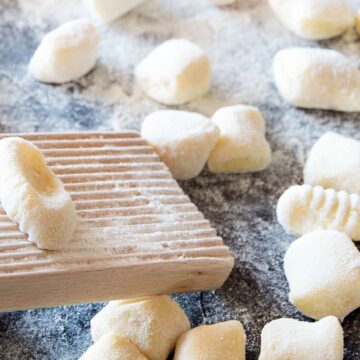
How To Make Potato Gnocchi - Step By Step
Ingredients
- 2.2 lb potatoes , 1 kilogram
- 2 heaping cups all purpose flour , 300 grams
- 1 egg
- Salt
Instructions
Boil potatoes
- Wash potatoes and put them in a large pot with cold water. Add salt. Bring potatoes to a boil and cook for 30-40 minutes until tender when poked with a fork. Once fork tender, remove potatoes from water immediately and let cool a little bit.
- At this point, you can peel off the skin or simply cut off any imperfections, cut in half, and later pass through the potato ricer which will hold the skin.TOP TIP: Choose potatoes more or less of the same size for even cooking.
Make gnocchi dough
- Sift about ⅓ of all flour on work surface PLUS set 3 tablespoons aside (that you'll add at the very end if needed or use it to roll the gnocchi).
- Rice potatoes placing them cut side down (if you've decided to keep the skin on), force the potato through, and remove the skin from the potato ricer.
- Using a dough scraper cut riced potatoes to help them cool down further.Add beaten egg, and a few pinches of salt. Incorporate briefly with the dough scraper. Cover the dough with the remaining flour and "chop" it into a crumbly dough.
- Using your hands compact the dough into a ball.Don't knead gnocchi dough as you would with pasta or bread dough. Instead help yourself with a dough scraper and simply FOLD the dough onto itself until all flour is incorporated.
Shape gnocchi
- Dust your work surface with flour and cut off a piece of dough.Roll a finger-thick rope, approx. ½ inch thick and cut it into ½- ⅔ inch pillows.
- Flour wooden gnocchi board. Using your thumb finger, press and roll each pillow over the gnocchi paddle.
- If you don't have gnocchi board handy, use a simple tool you sure have - a fork. Roll on the backside of a fork pressing lightly to form the ridges. You can also leave your gnocchi ridge-free. They'll taste great anyway. Once first batch is ready sprinkle it lightly with more flour to prevent from sticking and arrange on a tray.
- Repeat the process with the rest of the dough. Cook potato gnocchi within 30 minutes from making otherwise, freeze.
Cook gnocchi
- Cook gnocchi by dropping them in salted boiling water give a very gentle stir. Use a LARGE pot or cook in smaller batches. Don't worry, gnocchi cook very fast. Once they rise and float to the top they're are ready to drain.
- Don't use your classic colander. Use a skimmer spoon/strainer to drain gnocchi. This way you'll preserve already hot water and can continue cooking the next batch. Make sure the water comes again to a rolling boil before dropping the next batch.
How to freeze
- Line a tray, a board or a baking sheet with parchment paper and arrange gnocchi in a single layer. Pop in the freezer for 30-40 minutes or until they've become hard. Once frozen transfer to a zip-lock bag. They will keep in the freezer for up to 4 months.TIP: instead of lining with parchment paper you can dust with flour to prevent gnocchi from sticking to the board.
Notes
TOP TIPS
- Choose the right potatoes and cook them correctly. Mature/aged potatoes are the best. Never use freshly harvested or young/baby potatoes. Always boil potatoes for gnocchi with skin on. Don’t check on donness before 30 minute mark as you don’t want potatoes to absorb water through poked holes.
- Don’t knead the dough. If you knead gnocchi dough like pasta or bread dough it will need more flour, which will make your gnocchi hard instead of soft and pillowy. Instead, with the help of a dough scraper fold the dough onto itself several times until all flour is absorbed.
- Never let the dough rest. Start making gnocchi immediately once the dough is ready. No need to cover it with a towel either. If you let the dough rest it will soften too much will become impossible to work with.
- Dust work surface and gnocchi board with flour. This will prevent the dough from sticking.
- Cook in small batches. If you crowed the pot too much gnocchi will practically dissolve in water before they even cook. Use a slotted spoon to remove gnocchi that came afloat and use the same boiling water to cook the next batch.
HOW TO STORE
If you don’t plan to consume gnocchi immediately you have to options. Store them on a tray in fridge for up to 4 hours. Freeze following instructions for freezing.Nutrition
Nutrition information is automatically calculated, so should only be used as an approximation.
Buon Appetito!

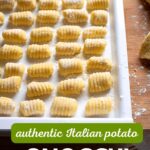
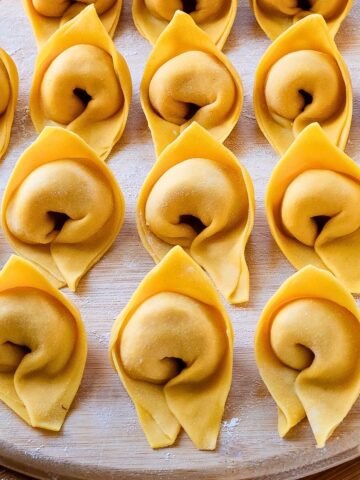
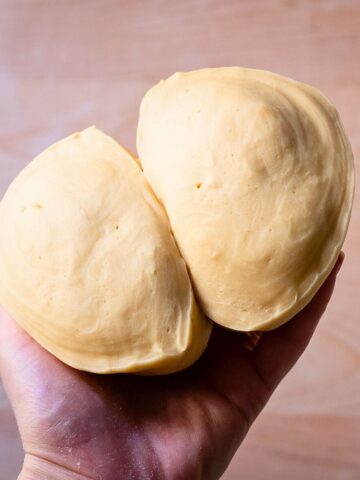
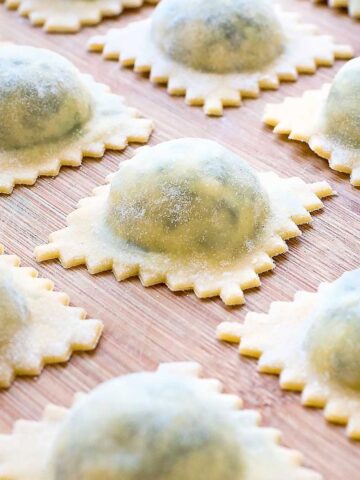
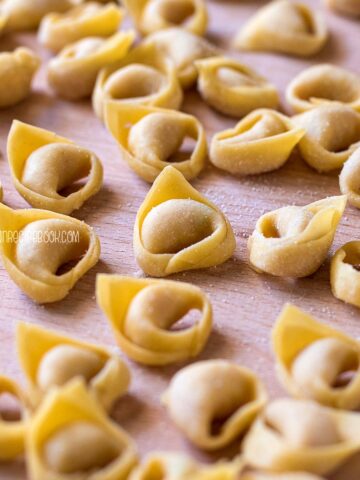
Cristallou says
Bonjour,
Je viens juste de finir les Gnocchis... je suis hyper contente car je les ai réussis Hier j'avais fait une autre recette mais à la fin j'ai dû tout jeter Moi qui ai horreur de jeter la nourriture ben là j'étais vraiment écœurée !
Mais c'était pas la recette la fautive mais moi... d'une part j'ai fais au robot avec le crochet et pétris trop longtemps même en rajoutant pas mal de farine c'était toujours trop liquide. D'une 2ème part j'ai laissé la pâte finie dans le robot pour répondre à ma maman qui m'appelais (30mn !).
Mais après avoir lu votre recette j'ai réalisé mes erreurs et j'étais ravie d'un côté parce que je savais pourquoi j'avais loupé donc je me suis dis que j'allais faire votre recette aujourd'hui... chose faite et je suis très très contente d'avoir réussi !
Je vais les mettre au congélateur pour en cuire samedi ou dimanche, mon fils sera là pour le week-end ! J'en emmènerais à ma maman lundi et ma fille. J'adore faire pour moi mais encore plus pour ma famille !!
MERCI BEAUCOUP POUR VOTRE PARTAGE ❤️
Maintenant plus qu'à goûter